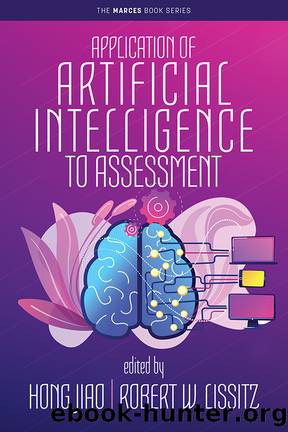Application of Artificial Intelligence to Assessment by Hong Jiao;

Author:Hong Jiao;
Language: eng
Format: epub
Publisher: Information Age Publishing
Published: 2020-03-10T15:50:01+00:00
Figure 5.2 Sentence to Sentence coherence in a Kaggle essay set.
Detecting Bias in Models
Machine learning models can be biased by training on non-construct relevant features (measurement bias) or by making inappropriate assumptions about the algorithms used to model those features (algorithm bias). But the models can also be biased by being trained on biased data (sample bias) or by not sampling subgroups appropriately (prejudice bias). Machine learning can leverage massive amounts of data to draw inferences. By âlearningâ from examples, and extracting patterns, it derives rules of what features in human behavior correspond to complex tasks. But if those examples contain bias, then the machine learning may infer that same bias. Three critical best practices in avoiding bias are to (a) select a broad sample of training examples to cover the range of possible input, (b) evaluate bias across subgroups and set criteria for effective performance, and (c) protect the model from scoring inappropriate input.
As an example, if students are given a writing prompt which asks: âWrite an essay about a hero and describe why this person is a hero to you,â there may be many ways for a student to describe what kind of a person fits their view of being a hero. Thus, it is important to capture the range of potential types of answers and not differentially penalize responses for the choice of their hero, instead of the quality of their explanation. This can be done by broadly selecting writing samples across the intended population, ensuring that responses from different subgroups are represented as well as using both high and low quality essays within the training sets.
Then, when a model is built, it should be tested against held-out data representing the various subgroups to ensure that different subgroups are not scored differently. For each of these subgroups, it is important to calculate various agreement indices (e.g., r, Kappa, Quadratic Kappa, Exact agreement, and standardized mean differences (SMDs) comparing humanâhuman results and with IEA-human results (see Williamson, Xi, & Breyer, 2012) . Significant differences between subgroups should be flagged and should determine whether the model is appropriate or needs additional training data before it is used.
Protecting the Model
Once a model is finally operationally deployed, it is important to ensure that the model only scores examples that are within the range of the assumptions that were made by the model. This can be considered protecting the model from inappropriate input, or maybe more properly, protecting the results from models that are not built for that kind of input. The features used to analyze the essays provide a means to ascertain how well any essay falls within the distributional confines of the training set. By analyzing the features of the essays from the training set, we can therefore derive an expected range of essay features. The system can then determine if the value for a particular feature or the combined values for a group of features are beyond the training range. Those that fall outside the confidence interval of this
Download
This site does not store any files on its server. We only index and link to content provided by other sites. Please contact the content providers to delete copyright contents if any and email us, we'll remove relevant links or contents immediately.
Exploring Deepfakes by Bryan Lyon and Matt Tora(8287)
Robo-Advisor with Python by Aki Ranin(8241)
Offensive Shellcode from Scratch by Rishalin Pillay(6386)
Microsoft 365 and SharePoint Online Cookbook by Gaurav Mahajan Sudeep Ghatak Nate Chamberlain Scott Brewster(5614)
Ego Is the Enemy by Ryan Holiday(5294)
Management Strategies for the Cloud Revolution: How Cloud Computing Is Transforming Business and Why You Can't Afford to Be Left Behind by Charles Babcock(4527)
Python for ArcGIS Pro by Silas Toms Bill Parker(4460)
Elevating React Web Development with Gatsby by Samuel Larsen-Disney(4182)
Machine Learning at Scale with H2O by Gregory Keys | David Whiting(4178)
Liar's Poker by Michael Lewis(3369)
Learning C# by Developing Games with Unity 2021 by Harrison Ferrone(3333)
Speed Up Your Python with Rust by Maxwell Flitton(3280)
OPNsense Beginner to Professional by Julio Cesar Bueno de Camargo(3251)
Extreme DAX by Michiel Rozema & Henk Vlootman(3236)
Agile Security Operations by Hinne Hettema(3160)
Linux Command Line and Shell Scripting Techniques by Vedran Dakic and Jasmin Redzepagic(3151)
Essential Cryptography for JavaScript Developers by Alessandro Segala(3122)
Cryptography Algorithms by Massimo Bertaccini(3057)
AI-Powered Commerce by Andy Pandharikar & Frederik Bussler(3022)
